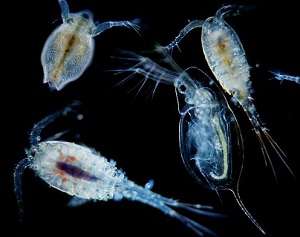Private Scuba › A-Z Sea-Life › Plankton
Facts about Plankton
The diverse family of translucent (colourless) and microscopic plankters create vital food pyramids in all freshwater and seawater environments.
This section explains the importance of planktonic organisms, especially phytoplankton and zooplankton, in marine ecosystems and oceanic food webs.
Where is Plankton and Why is it Important?
A simple definition of the word plankton is a tiny organism that 'drifts' or 'floats' in the water column.
In other words, they have no ability to swim or choose where they go.
In fact:
Thus, tides and currents are the mechanisms that carry them to a final destination.
Despite this fact - or because of it - plankton is the essential substance that supports the entire marine food web.
Important: The two leading types of plankton are phytoplankton (think of them as being plants) and zooplankton (e.g. microscopic invertebrate animals such as copepods).
Different Species of Plankton
In fact, more than 20,000 different plankton species exist in the oceans and in the air (e.g. bacterial, fungal, and aeroplankton). But, they all need sunlight to survive.
Phytoplankton
Like plants living in terrestrial habitats, phytoplankton also create energy through a process called photosynthesis (using chlorophyll and sunlight). As a result, they also absorb carbon dioxide and release oxygen into the water or the atmosphere.
 Thus, phytoplankton produce a prolific amount of oxygen (around 50% of all photosynthesis that occurs on the planet).
Thus, phytoplankton produce a prolific amount of oxygen (around 50% of all photosynthesis that occurs on the planet).
But to thrive, they also need some vital nutrients from their surroundings, including calcium, nitrate, and phosphate, nitrate.
You can find plankton living in freshwater bodies as well as saltwater seas and oceans. Hence, very high populations tend to give the water a green and brown colouring.
Pro Tip: In fact, clear water is a sign of low populations of planktons.
Zooplankton
Most small marine invertebrate animals, including zooplankton, consume huge amounts of phytoplankton in their diet. In turn, they become a natural food source for bigger aquatic crustaceans and other large fish species.
Interesting Fact: Bacterioplankton and virioplankton are two nanoscopic types of plankton that also float in the sea.
Plankton Blooms
We need substantial plankton populations to create thriving oceanic ecosystems. But, too many in a small area can lead to serious environmental issues.
So, what happens if the density swells too quickly? If so, some phytoplanktons will release dangerous toxins. Thus, sudden blooms of plankton can cause a red tide or concentrations of algae that are too high.
Here's the thing:
Conditions such as these are responsible for high fish mortality and damage caused to healthy marine biomes. But, the harmful effects of eating contaminated organisms (e.g. mercury poisoning from fish) can cause severe illness (and death).
In essence, the aquatic food chain is dependent on a healthy population of nanoscopic plants and animals. Yet, the rising sea temperatures and effects of climate change (called 'ocean acidification' in marine biology) still remain as serious threats to plankton populations.
Related Information and Help Guides
- Funny Fish Names Chosen by Zoologists
- What Exactly are Copepods Crustaceans?
- Zooplankton Fun Facts and Information
Note: The short tutorial video [3:37 seconds] presented by "BBC Earth" explains why plankton are among the most vital organisms on the planet.